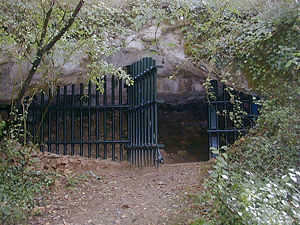
Grotte de Cussac
Encyclopedia

Dordogne River
The Dordogne is a river in south-central and southwest France.-Name:Contrary to appearances, the name of the Dordogne is not a recent word resulting from the names of the Dore and the Dogne...
valley in Le Buisson-de-Cadouin
Le Buisson-de-Cadouin
Le Buisson-de-Cadouin is a commune in the Dordogne department in southwestern France.It is connected with an ancient Roman road known as the Via Lemovicensis. The commune is situated by the Dordogne.-Population:-History:...
, Dordogne
Dordogne
Dordogne is a départment in south-west France. The départment is located in the region of Aquitaine, between the Loire valley and the High Pyrénées named after the great river Dordogne that runs through it...
, Aquitaine
Aquitaine
Aquitaine , archaic Guyenne/Guienne , is one of the 27 regions of France, in the south-western part of metropolitan France, along the Atlantic Ocean and the Pyrenees mountain range on the border with Spain. It comprises the 5 departments of Dordogne, :Lot et Garonne, :Pyrénées-Atlantiques, Landes...
, France
France
The French Republic , The French Republic , The French Republic , (commonly known as France , is a unitary semi-presidential republic in Western Europe with several overseas territories and islands located on other continents and in the Indian, Pacific, and Atlantic oceans. Metropolitan France...
.
The cave was discovered on September 30, 2000, by amateur speleologist
Speleology
Speleology is the scientific study of caves and other karst features, their make-up, structure, physical properties, history, life forms, and the processes by which they form and change over time...
Marc Delluc and formally announced by the French Ministry of Culture on December 8, 2000. It is currently under protection for scientific study, and closed to the public.
The cave's artworks are estimated to be 25,000 years old, and are almost exclusively engravings, often very large, made with stone tools on the walls, or with fingers on clay soil. Pigments are limited to very few red dots. They include both classic instances of Upper Paleolithic
Upper Paleolithic
The Upper Paleolithic is the third and last subdivision of the Paleolithic or Old Stone Age as it is understood in Europe, Africa and Asia. Very broadly it dates to between 40,000 and 10,000 years ago, roughly coinciding with the appearance of behavioral modernity and before the advent of...
animal art (bison
Bison
Members of the genus Bison are large, even-toed ungulates within the subfamily Bovinae. Two extant and four extinct species are recognized...
, horse
Horse
The horse is one of two extant subspecies of Equus ferus, or the wild horse. It is a single-hooved mammal belonging to the taxonomic family Equidae. The horse has evolved over the past 45 to 55 million years from a small multi-toed creature into the large, single-toed animal of today...
s, mammoth
Mammoth
A mammoth is any species of the extinct genus Mammuthus. These proboscideans are members of Elephantidae, the family of elephants and mammoths, and close relatives of modern elephants. They were often equipped with long curved tusks and, in northern species, a covering of long hair...
s, rhinoceros
Rhinoceros
Rhinoceros , also known as rhino, is a group of five extant species of odd-toed ungulates in the family Rhinocerotidae. Two of these species are native to Africa and three to southern Asia....
es, ibex) and rarer images including birds, enigmatic figures, and perhaps four female profiles. All appear close in theme and style of those known to Gravettien in the Quercy
Quercy
Quercy is a former province of France located in the country's southwest, bounded on the north by Limousin, on the west by Périgord and Agenais, on the south by Gascony and Languedoc, and on the east by Rouergue and Auvergne....
caves, in particular Pech Merle
Pech Merle
Pech Merle is a cave which opens onto a hillside at Cabrerets in the Lot département of the Midi-Pyrénées region in France, about 35 minutes by road east of Cahors. It is the home of one of the few prehistoric cave painting sites in France which remain open to the general public...
.
The cave's human remains appear to represent one of very few associations of parietal
Parietal
Parietal may refer to:*Parietal placentation*Parietal lobe of the brain*Parietal bone of the skull*Parietal scales of a snake lie in the general region of the parietal bone*Parietal cell in the stomach*Parietal pleura...
works and human burials in Paleolithic Europe
Paleolithic Europe
Paleolithic Europe refers to the Paleolithic period of Europe, a prehistoric era distinguished by the development of the first stone tools and which covers roughly 99% of human technological history...
. At least five people, four adults and a teenager, were deposited in the cavities, with bones dated by Carbon 14 measurements
Radiocarbon dating
Radiocarbon dating is a radiometric dating method that uses the naturally occurring radioisotope carbon-14 to estimate the age of carbon-bearing materials up to about 58,000 to 62,000 years. Raw, i.e. uncalibrated, radiocarbon ages are usually reported in radiocarbon years "Before Present" ,...
to approximately 25,000 years in age.

